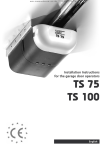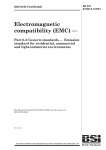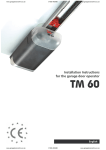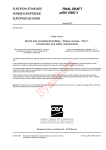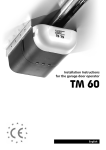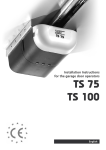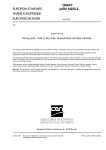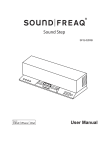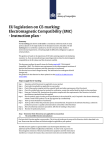Download FINAL DRAFT prEN 12445
Transcript
EUROPEAN STANDARD FINAL DRAFT prEN 12445 NORME EUROPÉENNE EUROPÄISCHE NORM July 2000 ICS 91.060.50 English version Industrial, commercial and garage doors and gates - Safety in use of power operated doors - Test methods Portes équipant les locaux industriels et commerciaux et les garages - Sécurité à l'utilisation des portes motorisées Méthodes d'essai Tore - Nutzungssicherheit kraftbetätigter Tore Prüfverfahren This draft European Standard is submitted to CEN members for formal vote. It has been drawn up by the Technical Committee CEN/TC 33. If this draft becomes a European Standard, CEN members are bound to comply with the CEN/CENELEC Internal Regulations which stipulate the conditions for giving this European Standard the status of a national standard without any alteration. This draft European Standard was established by CEN in three official versions (English, French, German). A version in any other language made by translation under the responsibility of a CEN member into its own language and notified to the Central Secretariat has the same status as the official versions. CEN members are the national standards bodies of Austria, Belgium, Czech Republic, Denmark, Finland, France, Germany, Greece, Iceland, Ireland, Italy, Luxembourg, Netherlands, Norway, Portugal, Spain, Sweden, Switzerland and United Kingdom. Warning : This document is not a European Standard. It is distributed for review and comments. It is subject to change without notice and shall not be referred to as a European Standard. EUROPEAN COMMITTEE FOR STANDARDIZATION COMITÉ EUROPÉEN DE NORMALISATION EUROPÄISCHES KOMITEE FÜR NORMUNG Central Secretariat: rue de Stassart, 36 © 2000 CEN All rights of exploitation in any form and by any means reserved worldwide for CEN national Members. B-1050 Brussels Ref. No. prEN 12445:2000 E Page 2 prEN 12445:2000 Contents page 1 Scope 5 2 Normative references 5 3 Terms and definitions 6 4 3.1 measuring point 6 3.2 direction of measurement 6 3.3 opening gap 6 Test method 6 4.1 General 4.1.1 Avoiding or safeguarding against crushing, shearing and drawing-in points 4.1.2 Safeguarding against hazard of being lifted 4.1.3 Safeguarding against impact hazards 4.2 Drive unit and power supply 4.2.1 Electrical drive unit 4.2.2 Electrical equipment 4.2.3 Additional requirements for hydraulic drive systems 4.2.4 Additional requirements for pneumatic drive systems 4.2.5 Controls 4.2.6 Switching on of the drive 4.2.7 Switching off of the drive 4.2.8 Manual actuators 4.2.9 Supply disconnecting device 4.2.10 EMC 8 8 8 8 9 9 9 9 9 10 10 4.3 10 Manual operation 4.4 Additional hazards 4.4.1 Pass doors 4.4.2 Trapping 4.4.3 Leaf travel limiting devices 4.4.4 Unintended movements of the door leaf 4.4.5 Interlocking 5 6 6 6 8 8 Force measuring method 10 10 10 10 10 10 11 5.1 Measuring equipment 5.1.1 Reference measuring equipment 5.1.2 Measuring equipment for "in situ" tests 11 11 11 5.2 Points of measuring 5.2.1 Sliding door 5.2.2 Hinged swing door 5.2.3 Folding door 5.2.4 Vertically moving doors 5.2.5 Barriers 11 12 13 15 16 18 Single fault failure 18 6.1 Force limiting devices 19 6.2 Other safeguarding devices 19 Page 3 prEN 12445:2000 7 Testing method for presence detection 7.1 8 Test pieces 19 19 7.2 Testing of presence detection equipment to be used in conjunction with force limitation 7.2.1 Testing of horizontal sliding and any type of vertically moving doors 7.2.2 Testing of hinged and folding doors 7.2.3 Testing of barriers 19 20 21 22 7.3 Testing of presence detection system to be used without force limitation 7.3.1 Testing of presence detection installed on the door leaf 7.3.2 Testing of presence detection not installed on the door leaf 23 23 24 7.4 25 Testing of presence detection in case of risk of being lifted Test report 25 Page 4 prEN 12445:2000 Foreword This European Standard has been prepared by Technical Committee CEN/TC 33 "Doors, windows, shutters, building hardware and curtain walling", the secretariat of which is held by AFNOR. This document is currently submitted to the Formal Vote. This standard is part of a series of European Standards for industrial, commercial and garage doors and gates, which are specified in prEN 13241:1998. No existing European Standard is superseded. Page 5 prEN 12445:2000 1 Scope This standard specifies the test methods to be applied to a power operated door to demonstrate compliance with the requirements specified in prEN 12453 : 2000. In particular it specifies the method of measuring the forces developed by a power operated door. It applies to any power operated door covered by prEN 12453 : 2000. 2 Normative references This European Standard incorporates, by dated or undated reference, provisions from other publications. These normative references are cited at the appropriate places in the text and the publications are listed hereafter. For dated references, subsequent amendments to or revisions of any of these publications apply to this European Standard only when incorporated in it by amendment or revision. For undated references the latest edition of the publication referred to applies. EN 983, Safety of machinery – Safety requirements for fluid power systems and their components – Pneumatics. EN 12433-1,Industrial, commercial and garage doors and gates – Terminology – Part 1: Types of doors. EN 12433-2, Industrial, commercial and garage doors and gates – Terminology – Part 2: Parts of doors. prEN 12453:2000, Industrial, commercial and garage doors and gates – Safety in use of power operated doors – Requirements. EN 12605, Industrial, commercial and garage doors and gates – Mechanical aspects – Test methods. prEN 12978:2000, Industrial, commercial and garage doors and gates – Safety devices for power operated doors and gates – Requirements and test methods. EN 50081-1, Electromagnetic compatibility – Generic emission standard – Part 1: Residential, commercial and light industry. EN 50081-2, Electromagnetic compatibility – Generic emission standard – Part 2: Industrial environment. EN 50082-1, Electromagnetic compatibility – Generic immunity standard – Part 1: Residential, commercial and light industry. EN 50082-2, Electromagnetic compatibilit – Generic immunity standard – Part 2: Industrial environment. EN 60204-1:1997, Safety of machinery – Electrical equipment of machines – Part 1: General requirements (IEC 60204-1:1997). EN 60335-1:1994, Safety of household and similar electrical appliances – Part 1: General requirements (IEC 60335-1:1991, modified). prEN 60335-2-95:1999, Safety of household and similar electrical appliances – Part 2-95: Particular requirements for drives for vertically moving garage doors for residential use (IEC 60335-2-95 : 1998, modified). IEC 60812, Analysis techniques for system reliability – Procedure for failure mode and effects analysis (FMEA). Page 6 prEN 12445:2000 3 Terms and definitions For the purpose of this standard, the following terms and definitions apply in addition as defined in EN 12433-1, EN 12433-2 and prEN 12453:2000. 3.1 measuring point specified point where measurements of force will be made 3.2 direction of measurement specified direction in which measurements of force will be made 3.3 opening gap clear distance between the main closing edge and the opposing closing edge or between the leaf and neighbouring hard parts of the surroundings 4 Test method The level of safeguarding of a power operated door, in respect of the requirements specified in prEN 12453:2000, shall be determined by the following tests and/or inspections. Non automatic one single household vertically moving domestic garage doors, excluding those which open onto public areas, may be excluded if these doors are driven by drives which fulfil the requirements of prEN 60335-2-95:1999. 4.1 General 4.1.1 Avoiding or safeguarding against crushing, shearing and drawing-in points Any crushing, shearing or drawing-in location shall be identified from a test specimen. For any identified hazardous location, a check shall be made to establish whether the hazard has been avoided or safeguarded. This check shall be done as follows: 4.1.1.1 Safety distance When a crushing, shearing or drawing-in point is avoided by the provision of a safety distance, this distance shall be checked by inspection and measuring, taking into consideration the endangered parts of the human body. 4.1.1.2 Force limitation When a crushing, shearing or drawing-in hazard is avoided by the provision of a force limitation system, this shall be checked by measuring the forces as specified in clause 5. The measured values shall be lower or equal to those mentioned in Annex A of prEN 12453:2000 and by the following tests and inspections. 4.1.1.2.1 Crushing point For any crushing point where the limitation of forces is achieved through force limiting devices or by devices for limitation of torque, electrical power, or pneumatic/hydraulic pressure, it shall be checked that these devices are properly designed by testing them according to prEN 12978:2000 and testing them against the single fault failure criteria as specified in clause 6. Page 7 prEN 12445:2000 4.1.1.2.2 Shearing point For any shearing point which occurs at secondary closing edges, it shall be checked that forces exerted by then door leaf are limited to less than 150 N static and to less than 400 N dynamic, when measured according to clause 5 and either a distance of at least 25 mm has been provided between passing edges or the passing edges have been provided with round edges with a radius of at least 2 mm for each edge and a combined value (sum of the 2 radii) of at least 6 mm has not been exceeded. 4.1.1.3 Shaping of leaf surfaces It shall be checked by inspection that the door leaf has no sharp edges, and that any part which protrudes shall cause no injury. 4.1.1.4 Hold-to-run-control When a door is operated via “Hold-to-run” control, it shall be checked by measurement that the door leaf stops when the manual control device is released, within the specified overrun distance and maximum static force as specified in 5.1.1.4 of prEN 12453:2000; by inspection that it is specified in the installation and user instructions that no manual controls other than hold to run control are to be installed and/or used; by inspection that when installed and operated in accordance with the installation and user instructions, the person controlling the door shall be in full view of the door and in the vicinity of the door during the leaf movement and shall not be in a hazardous position; by measurement that the speed of the primary edge is < 0,5 m/s. This speed shall be measured at the same points as those specified for force measurement for the type of door concerned (see clause 5). 4.1.1.5 Guard When guards such as enclosures, covers, enclosing guards or fixed protective leaves (screens) etc. are installed, it shall be checked by inspection that the danger points are safeguarded up to a height of 2,5 m above the floor to ensure that unprotected zones of the danger points do not remain, they are firm and resilient in respect of their safety-related function, they can be loosened only by use of a tool, they do not cause additional hazards, they cannot easily be defeated, bypassed or made ineffective. 4.1.1.6 Protective equipment For any pressure sensitive (PSPE), electro sensitive (ESPE) or inherent protective equipment, it shall be checked by testing that when part of a person is in the detection zone of the ESPE or a person applies the activating force at any point within the active area of the PSPE sensing element or when the signal from the sensing unit is within a specified signal range, an appropriate output signal(s) is given in accordance with prEN 12978:2000. It shall be also checked that the control command for stopping the hazardous leaf movement (off state of the output signal switching device) is maintained as long as the protective device is actuated, or until a signal for reversing the direction of movement of the door leaf is given, that the safeguarding function of the protective equipment is effective up to a height of 2,5 m above the floor in a way that unprotected zones of the danger points are eliminated, or by failure mode analysis that, in case a single fault occurs, the protective equipment behaves as specified in 5.1.1.6 of prEN 12453:2000. Page 8 prEN 12445:2000 It shall be also checked by measurement or test, that, in any case forces exerted by the door leaf are kept at acceptable values when measured according to clause 5 or the moving door is, in no circumstances, able to touch a person, as described in 7.3.2. 4.1.2 Safeguarding against hazard of being lifted When a door is designed in a way that it opens upwards and is not operated in the “hold-to-run” mode of operation, it shall be checked that it cannot give an adult or a child a lift, in a dangerous way, by checking that the door leaf is without apertures or protruding parts which could give the possibility to travel with or to be lifted. If there are possibilities to be lifted, it shall be checked that the door is not able to lift a mass of 20 kg (or 40 kg for doors installed in areas out of public access), from the closed position. The mass shall be attached onto the door leaf, in its most unfavourable position. The maximum dimension of the mass shall be 300 mm in any direction, or that, when the door is able to lift a mass of 20 kg (alternatively 40 kg), the door shall stop before the lifted body reaches the lintel or other fixed parts of the building (see 7.4). 4.1.3 Safeguarding against impact hazards Forces shall be measured on the main closing edges and at secondary edges, where persons can be pushed, as specified in clause 5. The measured values shall be less than the maximum values specified in Annex A of prEN 12453:2000. 4.2 Drive unit and power supply 4.2.1 Electrical drive unit The electric drive unit of the door to be tested, whatever is its type, shall be tested in accordance with EN 60335-1:1994, taking into account the modifications specified in 5.2.1 of prEN 12453:2000. 4.2.2 Electrical equipment Either by site inspection or by analysis of the installation instructions, it shall be checked that the electrical equipment of the door (outside the drive unit) is designed and constructed according to EN 60204-1:1997, with the exceptions and additions specified in 5.2.2 of prEN 12453 : 2000. 4.2.3 Additional requirements for hydraulic drive systems It shall be checked that hydraulic drive systems are in accordance with EN 982, equipped with a means to protect them against over pressure and a means which makes it possible to connect a measuring gauge, able to resist three times the working pressure, constructed in a way that, when a total loss of pressure occurs in the system, the door leaf immediately stops in accordance with 5.2.7 of prEN 12453:2000 or continues to operate at normal speed until it reaches a final end position where the fault is detected and further movement is prevented, designed in a way that entrapment of air is discouraged, not creating any hazardous situation, in particular an unexpected movement, when interruption of the power supply occurs. Page 9 prEN 12445:2000 4.2.4 Additional requirements for pneumatic drive systems It shall be checked that pneumatic drive systems are constructed in accordance with EN 983; not allowed to work with a working pressure higher than 1,2 MPa; equipped with means to adjust the working pressure, to protect them against over pressure, and a means which makes it possible to connect a measuring gauge; able to stand three times the working pressure; constructed so that uncontrolled hazardous movements are not created by variations of air compressibility. 4.2.5 Controls The parts of door controls which are also part of safety devices, such as control units and output signal switching devices of safety devices, control devices for limitation of forces, control devices for limiting the leaf travel shall be tested according to the relevant clauses 5, 6 and 7. 4.2.6 Switching on of the drive If the drive may be switched on by manual activation devices which are designed for impulse and/or automatic and/or remote-controlled and/or programmed control operation, it shall be checked by inspection and/or test that the danger points of the door are avoided or safeguarded. When danger points have to be avoided by safety distances and/or fixed guards and/or proper shaping of leaf surfaces, during the installation process, it shall be checked that all are properly addressed in the installation instructions. It shall be accepted that, in automatic mode of operation, the door leaf may move to the fully open position and stop, or the door leaf may automatically move to the closed position after a period of time at the fully open position. 4.2.7 Switching off of the drive 4.2.7.1 Switching off of the drive by stop-command It shall be checked by test, that the leaf movement stops and the drive is switched off, as soon as a stopcommand, as specified in 5.2.7.1 of prEN 12453:2000. 4.2.7.2 Switching-off of the drive in case of power supply interruption It shall be checked by test or inspection that, in case of interruption of the power supply during movement of the door leaf, the subsequent restart when the supply is restored does not lead to a dangerous situation. 4.2.8 Manual actuators It shall be checked that any manual actuators are provided in such a manner that when permanently installed, the person operating the controls is not in a hazardous position. Check to be carried out either on site or by checking that this item is correctly specified in the installation instructions, unintended operation of the manual controls is prevented (by inspection). Page 10 prEN 12445:2000 4.2.9 Supply disconnecting device It shall be checked that each door supplied with an electrical drive unit is equipped either with a supply disconnecting device which disconnects all incoming sources of supply, or with a plug-in system which can be used for isolation purposes. It shall also be checked that this supply disconnecting device or plug-in system is designed so that it can be safeguarded against unintentional and unauthorised switching on. For domestic applications, this safeguarding can be disregarded only if the disconnecting device is installed in vicinity of or in direct view from the drive unit. This shall be checked either on site or within the instructions for installation. 4.2.10 EMC Performance in respect of the EMC shall be checked by tests according to the applicable standards as specified in 5.2.10 of EN 12453:2000. 4.3 Manual operation When a manual operation is provided on a power operated door, compliance with 5.3 of prEN 12453:2000 shall be checked by inspection. It shall be checked that instructions for use are correctly documented in respect of this point. The physical effort needed to manually operate the door shall be measured in accordance with EN 12605. 4.4 4.4.1 Additional hazards Pass doors It shall be checked by inspection that, if a pass door is fitted in a power-operated door, a device exists which prevents movement of the drive as long as the pass-door is not in its fully closed position and stops the movement if the pass door is opened. 4.4.2 Trapping It shall be checked by inspection whether the door can be moved either by decoupling the drive from the door leaf or by actuation of the drive by easily accessible means. Where this is not possible, it shall be checked that the hazard of trapping is correctly specified in the installation and user manual. 4.4.3 Leaf travel limiting devices It shall be checked by inspection that the door leaf stops automatically and safely at its terminal travel positions and that, after a final stop, the door leaf remains in a safe state and does not create any hazard. 4.4.4 Unintended movements of the door leaf The door shall be tested in accordance with EN 12605. In particular, the activation of a manual release, if fitted, shall be checked to be safe in case of one failure in the suspension or balancing system. 4.4.5 Interlocking When a locking device is provided, it shall be checked that its activation does not create any dangerous situation. Page 11 prEN 12445:2000 5 Force measuring method The opening and closing forces developed by a power operated door shall be measured with equipment specified in 5.1. Dependant on the type of door and door movement, the points where the forces have to be measured and the direction of measurement are specified in 5.2. The measurements shall be performed on a complete door assembly, fully equipped with all safety devices incorporated and adjusted as specified in the instructions of the manufacturer. 5.1 Measuring equipment In the following, only the master instrument is specified as a reference instrument. The master instrument may also be used for site measurement. Should a more adaptable site measuring instrument be designed, such an instrument shall be calibrated at regular intervals. 5.1.1 Reference measuring equipment The test equipment for measuring forces shall consist of the following parts: two contact areas with a diameter of 80 mm 1 %. The contact areas shall be made of suitable material and be of sufficient thickness to retain rigidity; a spring which gives the contact area a spring ratio of 500 N/mm ± 50 N/mm; a load cell with an amplifier and a display unit, or any equivalent mechanical or electromechanical system. The test equipment used for measurement of forces versus time shall also be equipped with a plotter, XY recorder or similar. The test equipment shall fulfil the following data : measuring range from 25 N to 2000 N; rising / falling time of the load cell amplifier not > 5 ms. The equipment shall be calibrated and therefore be able to give measured values with an accuracy of at least 5 % or 10 N, whichever is the maximum deviation. 5.1.2 Measuring equipment for "in situ" tests Any equipment for "in-situ" testing shall be calibrated, with respect to force and time. Calibration shall be performed at least once per year. The equipment shall give measured values with an accuracy of at least 10 % or 20 N, whichever is the maximum deviation. 5.2 Points of measuring Three measurements shall be made at each measuring point. The mean average value obtained for each point has to fulfil the requirements. In the following, the points of measuring are specified for different door types, having to take the opening gap and direction of measurement into consideration. In addition to the specified measuring points, one additional measuring point shall be specified by the testing body, at random. The direction of measurement shall be parallel to the line of application of the spring force of the measuring instrument effected by the leaf during the process of measuring. The line of application shall be synchronised with the centre line of the spring inside the measuring instrument, and shall pass through the centre points of the hammerheads of the measuring instrument. Page 12 prEN 12445:2000 For doors with pressure sensitive protective equipment, where the contact area of the measuring instrument comes too close to the extreme end of the edge, it is accepted that the instrument is moved so that the measuring point is still covered by the contact area of the instrument and the distance between the extreme end of the closing edge and the edge of the contact area is 30 mm maximum. All dimensions specified in the following clauses and figures shall be within 5 % of the specified values. 5.2.1 Sliding door On a sliding door, the closing and opening forces shall be measured on both main and secondary closing edges. The forces shall be measured in the direction parallel to the direction of the movement of the closing edge. 5.2.1.1 Measuring between the main closing edge and the opposing edge, or between two main edges The measurement of forces shall be carried out at points located at three different heights (see figure 1) as follows: at 50 mm above the lower edge of the door; in the middle of the main closing edge or at a height of 2500 mm above the floor when the length of the main closing edge is > 5000 mm; and 300 mm below the upper edge of the door leaf or at a height of 2500 mm above the floor where the length of the main closing edge is > 2800 mm. Dimensions in millimetres Figure 1 — Points of measuring at the leaf of a sliding door and at the three different opening gaps (see figure 2) of 50 mm; 300 mm; and 500 mm between the main closing edge and the opposing edge. Page 13 prEN 12445:2000 Dimensions in millimetres Key 1 Direction of measuring force Figure 2 — Openings gaps between the main closing edge of a sliding door and the opposing edge 5.2.1.2 Measuring between the rear edge of the leaf and neighbouring hard parts of the surroundings The measurement of forces shall be carried out between the rear edge of the leaf and neighbouring stiff parts of the surroundings in a similar manner to the measuring of entrapment forces between the main closing edge and the opposing edge according to 5.2.1.1. The opening gap shall be determined between the most outstanding parts of the rear edge and the neighbouring parts of the surroundings. 5.2.2 Hinged swing door On a hinged swing door, the closing and opening forces shall be measured between the main and opposing edge and between the door leaf and any hard part of the surrounding. 5.2.2.1 Measuring between the main closing edge and the opposing closing edge, or between two main closing edges On hinged swing doors, measurement of forces shall be carried out at points situated at three different heights (see figure 3): 50 mm above the lower edge of the door; in the middle of the height of the door leaf or in a height of 2500 mm above the floor when the height of the door leaf is > 5000 mm; 300 mm below the upper edge of the door leaf or at a height of 2500 mm above the floor when the height of the door leaf is > 2800 mm, Page 14 prEN 12445:2000 Dimensions in millimetres Figure 3 — Points of measuring at the leaf of a hinged door and at the following three opening gaps (see figure 4): 50 mm; 300 mm; and 500 mm between the door leaf and the opposing edge turned towards the leaf. Dimensions in millimetres Key 1 Direction of measuring force Figure 4 — Opening gaps between the leaf of a hinged door and opposing closing edge For each measuring point, the forces shall be measured in the direction orthogonal to the closing edge, in the plane specified by the closing door edge and the opposing closing edge. 5.2.2.2 Measuring between the door leaf and neighbouring stiff parts of the surrounding The forces shall be measured (see figure 5) at right angles to the surface of the door leaf, at points situated at a distance of 1000 mm from the pivots of the door leaf or at the main closing edge of the door leaf when the width of the door leaf is < 1000 mm, and at the opening gap of 500 mm at a height of 1000 mm in case of smooth surfaces of the door leaf and the neighbouring wall or between the most outstanding parts of the door leaf and the neighbouring stiff parts of the surroundings up to a height of 2000 mm. The width of the contact area of outstanding parts shall not be < 100 mm, the contact area of these parts not < 0,1 m². Page 15 prEN 12445:2000 Dimensions in millimetres Key 1 Direction of measuring force Figure 5 — Points of measuring at the leaf of a hinged door and an opening width between the leaf and neighbouring stiff parts of the surroundings 5.2.3 Folding door On a folding door, the measurement of force shall be done in two different locations, specified as follows: 5.2.3.1 Measuring between the main closing edge and the opposing closing edge Measurement of forces between the main closing edge and the opposing closing edge shall be carried out observing the direction of the measured force at the points of measuring as required for sliding doors in 5.2.1(see figure 6). Dimensions in millimetres Key 1 Direction of measuring force Figure 6 — Measurement of forces on a folding door Page 16 prEN 12445:2000 5.2.3.2 Measuring between the folding leaf and neighbouring stiff parts of the surroundings Measurement of forces shall be carried out between a folding leaf and neighbouring stiff parts of surroundings observing the direction of the measuring force at the points of measuring as required for hinged doors in 5.2.2. 5.2.4 Vertically moving doors 5.2.4.1 Measuring forces at the main closing edge On any vertically moving door, forces shall be measured, in a vertical direction, between the main closing edge and the opposing edge (floor) at the following points of the main closing edge (see figure 7): in a distance of 200 mm from each lateral border of the horizontal clear distance of the door opening; and at the centre of the clear opening. Dimensions in millimetres Key 1 Direction of measuring force Figure 7 — Points of measuring at the leaf of a lifting door and at the opening gaps of (see figure 8): 50 mm; 300 mm; and 2500 mm, or, if the clear opening height is < 2800 mm, 300 mm below the fully open position of the door. For up and over doors < 2800 mm in height, the measurement at 300 mm below the fully open position need not be taken if the vertical component of the movement is less than the horizontal component. Page 17 prEN 12445:2000 Dimensions in millimetres Figure 8 — Opening gaps between the main closing edge of a lifting door and the opposing closing edge 5.2.4.2 Measuring forces between secondary closing edge and opposing edge When shearing hazards which occur on tilting doors between secondary closing edges are safeguarded by force limitation, entrapment forces shall be measured between the secondary closing edge and the opposing closing edge, against the movement, perpendicular to the door leaf at a point located 300 mm away from the crossing or pivoting point with the fixed edge when the angle between the door leaf and the fixed edge is 30° (see figure 9). Dimensions in millimetres Key 1 Crossing point 2 Point of measuring Figure 9 — Point of measuring on secondary edge of a tilting door Page 18 prEN 12445:2000 Measurement of the forces on secondary closing edges may be disregarded if the manufacturer of the door can demonstrate that forces, when measured on the secondary closing edge are always below the values obtained when the measurement is done on the main closing edge, under the same measuring conditions e.g. active or passive safety devices fitted in the same way, hard against hard, etc. 5.2.5 Barriers For barriers, the forces shall be measured at the measuring points specified below, in the direction perpendicular to the arm in the vertical plane between the arm to the ground. The force shall be measured at 200 mm from the end of the arm, and at a maximum height of 2 m above the ground, and at an angle with the horizontal of maximum 45° (see figure 10). When variable gaps between moving parts and the ground or fixed surroundings are decreasing during the downwards movement to < 300 mm, then measuring points have to be considered at gaps of 300 mm (see 10 b) and eventually 50 mm. Dimensions in millimetres Figure 10 — Points of measuring at barriers 6 Single fault failure When force limiting devices or other safeguarding devices are installed on a door, such devices shall not fail to danger when one single fault occurs, as required in prEN 12453 : 2000. This characteristic shall be checked as specified in 6.1. Page 19 prEN 12445:2000 6.1 Force limiting devices When the force limitation is achieved via a force limiting device, such a device shall not fail to danger and shall meet the requirements in 5.1.1.6 of prEN 12453:2000. This shall be checked either by tests according to clause 19 of EN 60335-1:1994. During the tests, the admissible values specified in Annex A of prEN 12453:2000 and measured as specified in clause 5 shall not be exceeded, or the door shall stop or 6.2 by an analysis according to the method specified in IEC 60812. Other safeguarding devices When a protective device shall not fail to danger in case a single fault occurs, this shall be checked either by tests according to clause 19 of EN 60335-1:1994. During the tests, the protective function shall remain or the door shall stop or 7 by an analysis according to the method specified in IEC 60812. Testing method for presence detection When a door is safeguarded using presence detection equipment, the correct installation of this equipment shall be assessed by using test pieces. These test pieces, when located according to the following and depending on the door type, shall have to be detected by the equipment, this shall make the moving door stop or reverse, and prevents a door at standstill from moving. When such equipment shall not fail to danger, this shall be checked as specified in 6.2. 7.1 Test pieces The following two test pieces shall be used: The A test piece is a hard parallelepiped specimen with dimensions of 700 mm x 300 mm x 200 mm. Three of the sides (one in each dimension) shall be reflective (e.g. mirror, fine grained stainless steel, white gloss paint) and the other three of dull black, painted rough wood. The B test piece is a hard cylinder 300 mm long, with an external diameter of 50 mm. Half of the outer surface shall be reflective (see above) and the other half of dull black, painted rough wood. If more convenient, two B test pieces can be used, one of steel and the other of wood, as specified above. NOTE Test pieces are designed to represent a human body and also correspond to the technical principles used in the protective device which is under test. Because of these demands it is recommended in some situations that comparison tests may be carried out with a human being, whenever possible and/or needed. 7.2 Testing of presence detection equipment to be used in conjunction with force limitation Such detection equipment, specified as type D, can be active on one or the other side of the door, or on both sides. The detection capability shall be tested on one or both sides as required. When active on both sides, it shall be verified that no conflict appears between both sides by checking that each test piece is correctly detected by the system active on the side of the door where the test piece is located. The test is carried out using one or two A test pieces, laid on the ground in specified locations, as specified in 7.2.1 according to the door type. Page 20 prEN 12445:2000 7.2.1 Testing of horizontal sliding and any type of vertically moving doors 7.2.1.1 Detection active on one side When the door is in the worst position, if one exists, and the A test piece is laid on the ground (see figure 11), the A test piece shall be detected at any position within the door aperture. Dimensions in millimetres Key 1 Side of presence detection to test Figure 11 — Testing a presence detection with the A test piece 7.2.1.2 Detection active on both sides The position of the closed door edge shall be marked on the ground. When the door leaf is in the worst position, if one exists, and the two A test pieces are placed on the ground (see figure 12), they shall be detected. Dimensions in millimetres Figure 12 — Testing of two coupled presence detection Page 21 prEN 12445:2000 When moved in the door aperture in any position between locations A and B (see figure 13), the A test piece 1, placed on the inside, shall be detected by the inside presence detection equipment, and the A test piece 2, placed on the outside, shall be detected by the outside presence detection equipment. Dimensions in millimetres Figure 13 — Testing two coupled presence detection devices 7.2.2 Testing of hinged and folding doors 7.2.2.1 Detection active on one side When the door is in the worst position, if one exists, and the A test piece is located on the ground (see figure 14), it shall be detected. Dimensions in millimetres Key 1 Side of presence detection Figure 14 – Testing a presence detection with the A test piece on a hinged door 7.2.2.2 Detection active on both sides The projections of the door leaf, when closed and opened, are first drawn on the ground. Then the leaf is located in a half closed position. When the door leaf is half closed, the two A test pieces located on the ground (see figure 15) shall be detected: the A test piece1 shall be detected by the inside presence detection, and the A test piece 2 shall be detected by the outside presence detection. Page 22 prEN 12445:2000 Dimensions in millimetres Figure 15 – Testing two coupled presence detection devices on hinged doors 7.2.3 Testing of barriers When only one detection system exists, the A test piece, when located as shown in figure 16, shall be detected. Dimensions in millimetres Figure 16 – Testing a presence detection with the test piece A on a barrier When two presence detection systems are active, two A test pieces, when located as shown in figure 17, shall be detected. Dimensions in millimetres Figure 17 – Testing two presence detection on a barrier Page 23 prEN 12445:2000 7.3 Testing of presence detection system to be used without force limitation Such detection equipment, specified as type E, has to be active in the whole dangerous area of movement. The detection capability shall be tested in the whole area. The test is carried out using both A and B test pieces, as specified in 7.3.1 according to the door type. 7.3.1 Testing of presence detection installed on the door leaf The B test piece shall be located in all the points specified in 5.2 where the operating forces have to be measured. For barriers, the B test piece shall be additionally located every 500 mm along the arm. The B test piece shall be located with its axis horizontal and orthogonal to the plane specified by the position of the door leaf (or barrier’s arm) when in closed position, with the exception of hinged doors (see figure 18) a to f)). Figure 18– Testing a contactless presence detection For hinged doors, the B test piece shall be located horizontal with its axis at an angle of 45° with the plane specified by the position of the door leaf when in closed position (see figure 18 d) to f)). When tested at each position, it shall be verified that no contact occurs between the B test piece and the closing door leaf (or barrier’s arm), which shall stop and/or reverse. For doors and barriers, the A test pieces shall be located vertically in the path of the door leaf or barrier arm, when it is closing, to verify that the A test piece is detected. The door leaf or barrier arm shall stop and/ or reverse and no contact shall occur between the door leaf or barrier arm and the A test piece. For hinged doors, the A test piece shall be located vertically adjacent to the maximum radius of the swept area of the door, to verify that the door leaf stops and / or reverses and no contact occurs between the door leaf and the A test piece, when the door is closing. This procedure shall be repeated when the door is opening. Page 24 prEN 12445:2000 Dimensions in millimetres Figure 18 – Testing a contactless presence detection 7.3.2 Testing of presence detection not installed on the door leaf 7.3.2.1 Testing of presence detection providing a safety distance to the door leaf It shall be verified by inspection that the electro-sensitive-protective equipment is located and installed in a suitable manner to prevent it from being damaged or rendered inoperative during any foreseeable operating conditions. It shall also be verified by inspection that it is only adjustable by using tools and is accessible for inspection purposes. The extent of the detection zone of the protective equipment shall be verified, by moving the A test piece, positioned vertically, to different locations on the ground. Page 25 prEN 12445:2000 It shall be verified by testing that the detection zone of the equipment covers, as a minimum, the dangerous area of the door. The dangerous area is specified as the projection on the ground of the volume containing the door leaf in any position during movement up to a height of 2,5 m above the floor and increased by a safety distance d in any direction. The safety distance d shall depend upon the closing speed of the door leaf. It shall not be < 200 mm and, for a door closing at a speed equal to or greater than 0,5 m/s, d shall be 900 mm. It shall be verified, by using the A test piece, positioned vertically on the ground, that if the A test piece is located anywhere in the dangerous area, when the door is closing, the door leaf stops and / or reverses and no contact occurs between the door leaf and the A test piece. This test shall also be made when door is opening, for hinged and folding doors. if the A test piece is located anywhere in the detection zone, when the door is closing, the door leaf stops and / or reverses and no contact occurs between the door leaf and the A test piece. whilst the A test piece is in the detection zone, a control command is continually given, and the door leaf is prevented from any hazardous movement. It shall be checked that the equipment shall not fail to danger as specified in 6.2. 7.3.2.2 Testing of presence detection acting directly in the door leaf plane of vertically operating doors The device shall be tested when the door is closing. It shall be verified, by using the following test piece positioned anywhere in the plane in which the door leaf moves, that the test piece are detected and the door leaf shall stop or reverse without any contact to the test piece: the B test piece up to 300 mm above floor level; the A test piece in its dimension 200 mm in a height from 300 mm to 2500 mm above floor level. 7.4 Testing of presence detection in case of risk of being lifted When there is a risk of being lifted, it shall be tested that the lifted body is detected and the movement is stopped. Using the test piece A, attached vertically to the door leaf in the most critical position, the test piece shall be detected before reaching the hazardous location. If the test piece is not detected before reaching the hazardous location, the B test piece shall be used and introduced where possible in the dangerous zone. It shall be detected and the movement shall be stopped. 8 Test report All results of tests shall be properly documented and recorded in a test report. The test report shall at least include the following information: name of the test institute, if involved; name of the manufacturer; identification of the tested door; data supplied regarding installation and adjustment; date of test; description of test equipment and test conditions; test results of each test carried out; special observations regarding the test specimen and the test results.




























